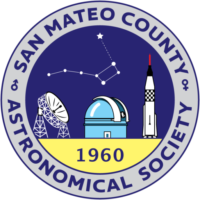May 2, 7:30 pm PDT Program Starts
in the CSM Planetarium with the Michael Chriss Scholarship Award Winner talks, details below, followed at 8:00 pm by Dr Pascal Lee
Free and open to the public. In the College of San Mateo Planetarium. Free parking in nearby lots, eg Lot S (5) or Lot R. Click here for Google map/directions
CSM Astronomy Department 2025 Michael Chriss Scholarship Award Winners Presentations
Belle Blevins-Kurt: Binary Star Discovery & Behavior
Malia Smith: All About JuMBOs
Each speaker will do a short presentation on their research. Abstracts and biographies below.
Belle Blevins-Kurt:
Binary Star Discovery and Behavior

Binary star systems and multiple star systems currently make up more than half of the star systems we observe. These stellar systems were first discovered in 1803 by William Herschel, and since then, they have maintained their place as objects of interest; we can only obtain so much information from a star alone, but a star system allows us to gather much more information on multiple stars based on how they interact with each other.
One binary star system that astronomers have been keeping a close eye on is T Coronae Borealis, consisting of a white dwarf and red giant star. Due to its close orbit, the white dwarf component collects hydrogen from the red giant, creating a recurring nova explosion where it blasts off its shell of hydrogen about every 80 years. According to recent reports from astronomers, we’re close to the predicted time for the next nova explosion. In this paper, we seek to synthesize information on the discovery and behavior of binary star systems like T Coronae Borealis.
Belle is currently 17 years old and began her studies in astrophysics two years ago at College of San Mateo. Since then, she has been focused on advancing her knowledge of science, especially in regards to astronomy and physics. Additionally, Belle dedicates time to astronomy outside of class, as she runs the College of San Mateo Astronomy Club and volunteers at the school’s observatory weekly. Her next academic milestone will be when she transfers to a 4-year university for astrophysics in the fall of 2026.
Malia Smith:
All About JuMBOs

In late 2023, astronomers using NASA’s James Webb Telescope discovered 40 pairs of Jupiter-mass binary Objects, otherwise known as JuMBOs, within the Orion Nebula. This discovery has challenged long-held theories of planetary and stellar formation, raising intriguing questions and opening up new possibilities for refining our existing models of cosmic processes. Using data primarily from peer-reviewed research, this presentation explores the nature of JuMBOs, the leading hypotheses on their formation, and why their existence is shocking to the scientific community. Additionally, it includes a brief section detailing my personal observations of the Orion Nebula through astrophotography, offering some stunning visuals to complement the broader scientific discourse.
Malia is an honors program student actively working toward her associate’s degree in physics, with plans to transfer to a four-year university to pursue a bachelor’s degree in astrophysics. Her long-term goal is to earn a master’s degree and work in a research role at a leading space science organization. Beyond her passion for space science, Malia has a deep interest in psychology, mathematics, and chemistry. She is also a talented artist whose work has been recognized at the Coastal Arts League Gallery in Half Moon Bay. An avid traveler, she has visited 14 countries and is a certified scuba diver. In her free time, Malia enjoys oil painting, reading true-crime novels, and embracing new adventures. Known for her determination, creativity, and relentless curiosity, she is committed to pushing the boundaries of knowledge in both science and art. More information about her is in this great YouTube video produced by the College of San Mateo:
